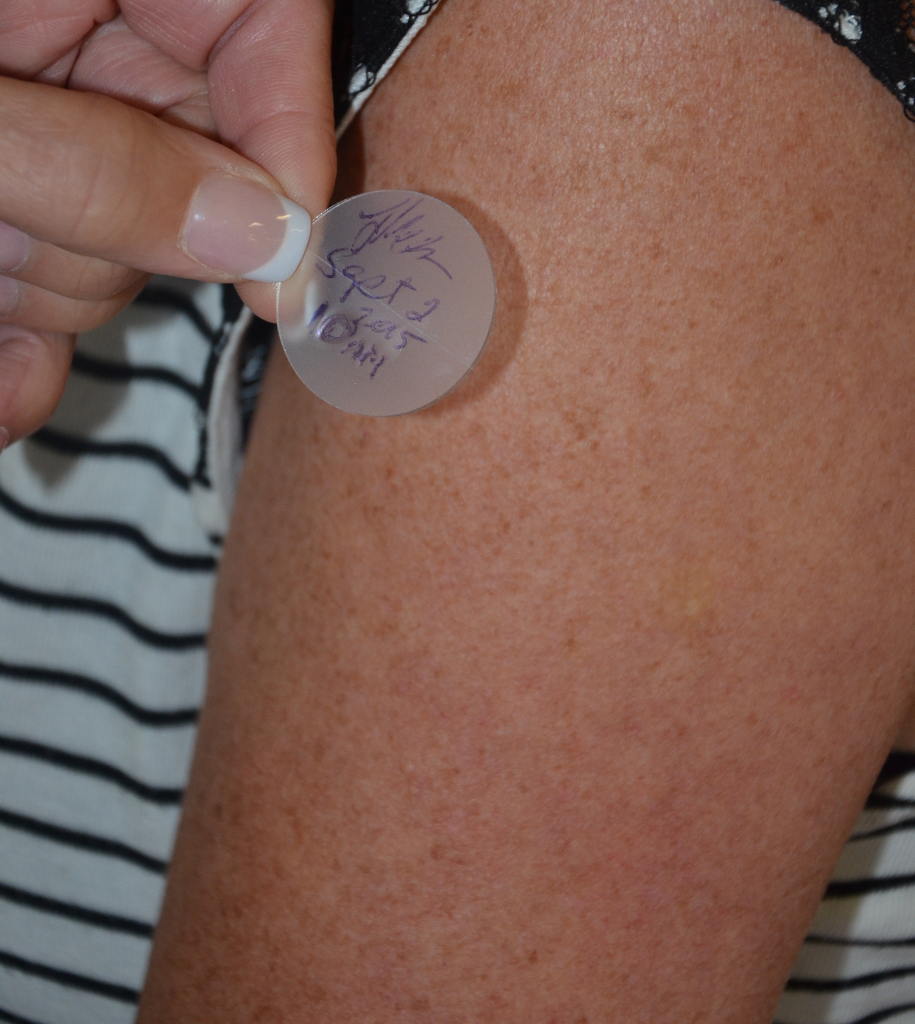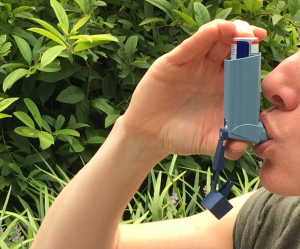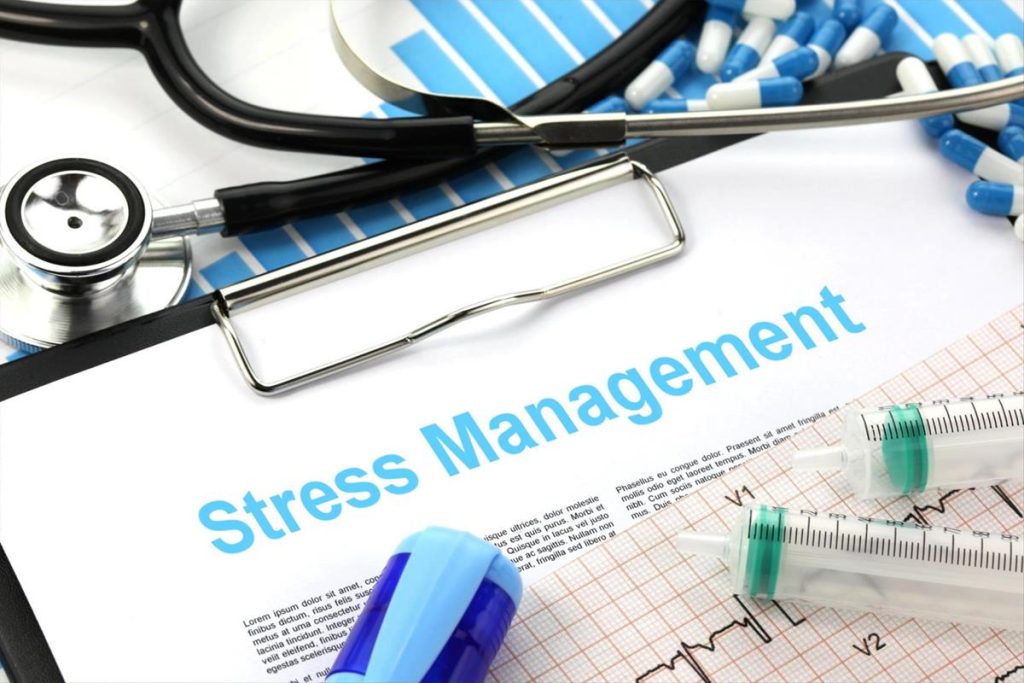Absorption
Open Resources for Nursing (Open RN)
Absorption
The first stage of pharmacokinetics is known as absorption. Absorption occurs after drugs enter the body and travel from the site of administration into the body’s circulation. Medications can enter the body through various routes. Common routes to administer medications include the following examples:
- Oral (swallowing an aspirin tablet)
- Enteral (administering medication into the gastrointestinal tract via a nasogastric tube)
- Rectal (administering an acetaminophen suppository)
- Intranasal (spraying allergy medication into the nose)
- Inhalation (breathing in asthma medication from an inhaler)
- Intramuscular (injecting an influenza vaccine into the deltoid muscle)
- Subcutaneous (injecting insulin into the subcutaneous tissue in the abdomen)
- Transdermal (wearing a nicotine patch that is absorbed through the skin)
- Intravenous (administering antibiotics directly into a vein)
First-Pass Effect
When a medication is administered orally or enterally, absorption may be significantly hindered in the gastrointestinal (GI) tract. For example, when medications made of protein are introduced into the GI tract, they can be quickly deactivated by enzymes as they pass through the stomach and duodenum. If some of the drug is absorbed from the intestine into the bloodstream, part of the absorbed portion may be broken down by liver enzymes, whereas the remaining part escapes into the general circulation. The portion of the drug that enters the general circulation will either become protein-bound (and thus inactive) or remain free to circulate and create an action at a receptor site. This entire process that results in reduced concentration of active drug available in an individual’s circulation is known as the first-pass effect. Due to the first-pass effect, prescribing providers and nurses administering medications must understand that several doses of an oral medication may be needed before enough free drug stays active in the circulation to exert the desired effect. These metabolic effects are further described in the “Metabolism” section later in this chapter.
Alternate Routes
A workaround to the first-pass effect is to administer medication using alternate routes to the GI tract. Examples of alternative routes that avoid the first-pass effect include transdermal, nasal, inhalation, injection, or intravenous administration of medication. Alternative routes of medication administration bypass the first-pass effect by entering the bloodstream directly or via absorption through the skin or lungs. For example, pain relievers may be administered directly into the bloodstream (referred to as intravenous medications) so they are quickly available for distribution to tissues within the body.
Alternative routes of medication have other potential considerations. For example, injections are often painful and cause a break in the skin, an important barrier to infection. They can also be costly and difficult to administer daily, may cause localized side effects, or contribute to unpredictable fluctuations in medication blood levels.
Transdermal application of medication is an alternate route that has the primary benefit of slow, steady drug delivery directly to the bloodstream, without passing through the liver first. See Figure 1.2[1] for an image of a client self-administering a transdermal patch. Drugs delivered transdermally enter the blood via a meshwork of small arteries, veins, and capillaries in the skin. This makes the transdermal route of drug delivery particularly useful when a medication must be administered over a longer period of time to control symptoms. For example, transdermal application of fentanyl, a pain medication, can provide effective pain management over a several hours; a scopolamine patch can control motion sickness over the duration of a cruise ship vacation; and a nitroglycerin patch is used to prevent chronic chest pain. Despite their advantages, transdermal patches have a significant drawback in that only very small drug molecules can enter the body through the skin, making this application route inappropriate for some types of medications.

Inhaling drugs through the nose or mouth is another alternative route for rapid medication delivery that bypasses the liver. See Figure 1.3 for an image of a client self-administering an inhaler.[2] Metered-dose inhalers have been a mainstay of asthma therapy for several years, and nasal steroid medications are often prescribed for allergy and sinus problems.

Emerging Discoveries and Recent Developments
Researchers are currently exploring alternative methods of drug delivery such as the use of inhaled insulin powders. Afrezza® is an example of an inhaled insulin approved by the Food and Drug Administration (FDA) to assist with blood sugar control. This technology stems from novel uses of chemistry and engineering to manufacture insulin particles of just the right size for absorption. If too large, the insulin particles could lodge in the lungs; if too small, the particles will be exhaled.[3]
Life Span Considerations
Neonate & Pediatric
Gastric absorption in neonates and pediatric clients varies from adults. In infants, the acid-producing cells of the stomach are immature until around the age of one to two years. Additionally, gastric emptying may be decreased because of slowed or irregular peristalsis (coordinated muscle movements of the intestines).
The liver of infants and children is not fully mature, resulting in a decrease in first-pass elimination and subsequently higher drug levels in the bloodstream.[4]
Older Adult
As a natural result of aging, older adults will experience decreased blood flow to tissues within the GI tract. In addition, there may be changes in the gastric (stomach) pH that may alter the absorption of certain medications. Older adult clients may also experience variations in available plasma proteins, which can impact drug levels of medications that are highly protein-bound.
Consideration must also be given to the use of subcutaneous and intramuscular injections in older clients experiencing decreased cardiac output because decreased drug absorption of medications can occur when peripheral circulation is decreased. Additionally, as adults age, they often have less subcutaneous fat, resulting in decreased absorption of medication from transdermal patches that require adequate subcutaneous fat stores for proper absorption.[5]
The box below summarizes route considerations that a nurse should consider when administering medication.
Route Considerations
Oral (PO) or Enteral (NGT, GT, OGT) Ingestion
- Oral route is a convenient route for administration of solid and liquid formulations.
- Additional variables that may influence the rate and extent of absorption include enteric coating or extended-release formulations, acidity of gastric contents, gastric emptying rate, dietary contents, and presence of other drugs.
- First-pass effect: Blood containing the absorbed drug passes through the liver, which can deactivate a substantial amount of the drug and decrease its bioavailability (the percentage of dose that reaches the systemic circulation).
Parenteral Injection
- Subcutaneous and intramuscular administration: Injections can be difficult for clients to self-administer at home or to administer on a daily basis. They can be costly and painful. Injections also cause a break in skin that is an important barrier to infection, can cause fluctuation in drug levels, and can cause localized side effects to skin, such as bruising, redness, bleeding, and swelling.
- Intravenous (IV): IV drugs are fully available to tissues after administration into the bloodstream, offering complete bioavailability and an immediate effect. However, this route requires intravenous access that can be painful to the client and also increases risk for infection. Medications must be administered in sterile fashion, and if two products are administered simultaneously, their compatibility must be verified. There is also an increased risk of toxicity to the kidneys or liver.
Pulmonary Inhalation
- Inhalation allows for rapid absorption of drugs in gaseous, vaporized, or aerosol form through the lung tissue.
- Absorption of particulates/aerosols depends on particle/droplet size, which influences depth of entry through the pulmonary tree to reach the alveoli.
- The ability of the client to create successful inhalation, especially in the presence of bronchospasm, may also influence depth of entry in the pulmonary tree.
Topical and Transdermal Application
- Topical creams, lotions, and ointments are generally used for local effect; transdermal patch formulations are used for systemic effect.
- Absorption through the buccal or sublingual membranes may be rapid and is used for systemic effect.
- Absorption through skin is generally slower but produces a steady, long-term effect that avoids the first-pass effect. However, absorption of medication is affected by blood flow to the skin.[6] For this reason, heat and cold applications should not be used over transdermal medications.
Media Attributions
- Applying transdermal patch © British Columbia Institute of Technology (BCIT) is licensed under a CC BY (Attribution) license
- Adult Using Asthma Inhaler © NIAID is licensed under a CC BY (Attribution) license
- “Applying transdermal patch.jpg” by British Columbia Institute of Technology (BCIT) is licensed under CC BY 4.0 ↵
- “Adult Using Asthma Inhaler” by NIAID is licensed under CC BY 2.0 ↵
- This work is a derivative of Medicines by Design by US Department of Health and Human Services, National Institutes of Health, National Institute of General Medical Sciences and is available in the Public Domain. ↵
- Fernandez, E., Perez, R., Hernandez, A., Tejada, P., Arteta, M., & Ramos, J. T. (2011). Factors and mechanisms for pharmacokinetic differences between pediatric population and adults. Pharmaceutics, 3(1), 53–72. https://doi.org/10.3390/pharmaceutics3010053 ↵
- Fernandez, E., Perez, R., Hernandez, A., Tejada, P., Arteta, M., & Ramos, J. T. (2011). Factors and mechanisms for pharmacokinetic differences between pediatric population and adults. Pharmaceutics, 3(1), 53–72. https://doi.org/10.3390/pharmaceutics3010053 ↵
- This work is a derivative of Principles of Pharmacology by LibreTexts and is licensed under CC BY-NC-SA 4.0 ↵
With the increased emphasis on the impact of stress for health care professionals, many organizations and nursing programs have identified resources for formal stress reduction and mitigation. See Figure 12.7[1] for an illustration of stress management. Many of these models and resources have emerged as a professional necessity to help facilitate coping for individuals encountering innumerable job-related stressors. The U.S. Department of Veterans Affairs developed a Stress First Aid (SFA) framework to improve stress management in oneself and in others.[2] Many organizations are moving to frameworks such as the Stress First Aid framework and other stress management programs to help provide health care professionals with the knowledge, skills, and resources to aid in stress management reduction.
The Stress First Aid (SFA) framework offers the health care professional an opportunity to examine stress along a continuum, from normal stress that allows for adaptive functioning to signs of harmful stress requiring intensive intervention. It provides health care professionals with core functions for progressing through stress identification and resolution. The seven core functions are: Check, Coordinate, Cover, Calm, Connect, Competence, and Confidence.[3] The SFA model encourages health care professionals to self-reflect on a stress experience and take action to facilitate self-resolution and resource identification.

Many health care organizations embrace wellness as a foundational tenet of workplace culture. They have dedicated wellness committees or wellness champions who promote initiatives aimed at improving stress management among staff.[4] These formalized committees or positions reflect organizational commitment to the importance of self-care and personal wellness. When nursing graduates are interviewing for their first nursing positions, wellness initiatives may be a consideration when exploring professional employment benefits and organizational support structures.
The impact of wellness and stress-reduction strategies is often included in new hire orientation and nurse residency programs. Many nurse residency programs formally acknowledge in their curriculum that novice nurses must be educated about the signs of stress.[5] Novice nurses are particularly vulnerable to harmful stressors during their role transition. Many organizations provide training about strategies and resources to assist with coping and stress reduction, which is referred to as resiliency training programs.[6] Resiliency training fosters feelings of mindfulness, sensitivity to self, and professional development techniques that contribute to long-term engagement in the profession.
Read about ways to manage stress from the U.S. Department of Health and Human Services Office on Women's Health.
Sample Documentation of Expected Findings
IV catheter on right hand discontinued with catheter tip intact. Site free from redness, warmth, tenderness, or swelling. Gauze applied with pressure for one minute with no bleeding noted. Dressing applied to site.
Sample Documentation of Unexpected Findings
IV catheter on right hand discontinued with IV catheter tip intact. Site free from redness, warmth, tenderness, or swelling. Gauze applied with pressure for one minute. Bleeding noted to continue around gauze dressing. Pressure held for five minutes, and hemostasis achieved. Dressing applied to site.

